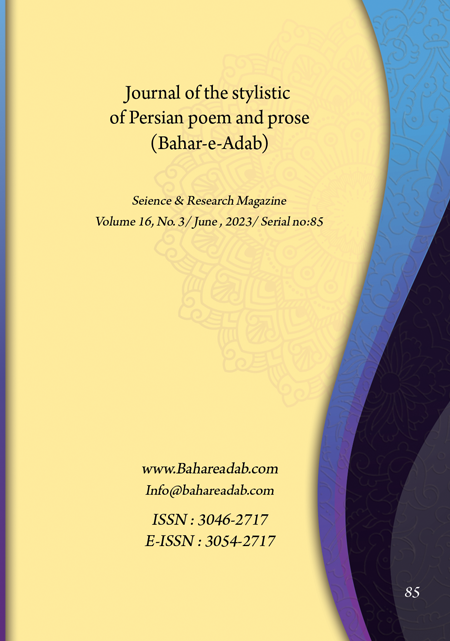- Count View : 394
- آدرس کوتاه شده مقاله: https://bahareadab.com/article_id/1458
- کد doi مقاله: Doi: 10.22034/bahareadab.2023 .16 .6870
Journal of the stylistic of Persian poem and prose
volume Number 16،
number In Volume 3،
،
issue Number 85
Study of folk language and literature in Holy Defense novels (The Baq Bolour, Del Deldadegi, Zamin Soukhte, Zamestan 62)
Yazdan Pakmehr , Musa Parnian (Author in Charge), Khalil Baygzadeh
Abstract
BACKGROUND AND OBJECTIVES: Folk language and literature is one of the important indicators in the spiritual culture of any country, which has had more or less influence in Persian literature since long ago. Through the growth and expansion of Iranian fiction literature in the last hundred years and the tendency to use the elements of popular language and literature in the works created, we can see a significant growth of the reflection of popular language and literature in contemporary literature, especially in fiction. The sacred defense literature, especially the story, is no exception to this rule. The writers of the holy defense stories have also used elements of popular language and literature in accordance with the atmosphere and characters of their stories.
METHODOLOGY: The present research was carried out by descriptive-analytical method, the elements of popular literature in four stories of holy defense (Bagh Bolour, Dele Deldadegi, Zamin Sokhte, Zemesta62) were studied.
FINDINGS: The authors of the holy defense stories, especially the stories studied in this research, were not inadvertence to the popular literature and used popular language and literature in advancing their narrative and in characterizing and creating atmosphere. In such a way that most of the slang terms, words and verses are expressed by the language of popular personalities, which shows the knowledge and mastery of these writers on the popular language and culture of Iran.
CONCLUSION: The results show that the elements of popular language and literature in the story of Zemestan62 had less reflection compared to the other three works; Because most of the characters in this story are people with university education who interact in an office environment. While the characters of the other three stories (Bagh Bolur, Dele Deldadegi, Zamin Sokhte) are ordinary people and they interact in the streets and markets, and their conversations are full of words, idioms and folk literature.
Keyword
Persian novel
, folk literature
, Holy defense
, Baq Bolour
, Del Deldadegi
, Zamin Soukhte
, Zamestan 62.
- Ajakianos, A. (2018). A Criticism of the Collection of Works Fasih and Some Stories by Ahmad Mahmood, Zoya Pirzad, Amir Hossein Chehelten, Fataneh Haj Seyyed Javadi. Tehran: Persian Language and Literature Academy, p. 100.
- Amini, A. (1989). Popular Culture or Interpretation of Farsi Proverbs. Isfahan: Isfahan University Press. P.2.
- Ashoori, D. (2001). Definitions and Concept of Culture. Tehran: Agah, p. 51.
- Beihaghi, H. (1989). Research and Study of Iranian Folk Culture. Mashhad: Astan Qods Razavi, p.21,36.
- Dad, S. (2011). Culture of Literary Idioms. Tehran: Morvarid, p. 24.
- Dastgheib, A. (1999). A Critique of the Works of Ahmad Mahmoud. Tehran: Moein, p. 50.
- Fassih, I. (2018). Zemestan 62. Tehran: Zehnaviz.
- Haghshenas, A.M. (2000). Folk or Spoken Persian Culture, Which? Danesh. 17 (2). pp. 59-65.
- Hajizade Mimandi, M. (2005). Research Pattern in Popular Culture. Yazd: Edaryeh kole Farhng and Ershad Eslami Ostan Yazd Ba Hamkari Entesharat Elme Novin, p. 54.
- Hanif, M. and Hanif, M. (2009). Excavations on Fiction and Holy Defense Fiction Literature. Tehran: Sarir, p. 70.
- Hassan Beygi, I. (2013). War and His Novels. Tehran: Soroush, p. 80.
- Hedayat, S. (1956). Neyrangestan. Second Edition. Tehran: AmirKabir, p. 9.
- Kowsari, M. (2000). Reflection on the Sociology of Literature (Article Collection). Tehran: Baz, p. 100.
- Mahjub, M. (2003). Iranian Folk Literature. by Hassan Zolfaghari. Tehran: Cheshmeh, p. 35.
- Mahmoud, A. (1979). Zamin Sokhteh. Tehran: Moein.
- Makhmalbaf, M. (1991). Baqe Bolour. Tehran: Ney.
- Mandanipour, Sh. (2000). Dele Deldadagi. Tehran: Zaryab.
- Masoumi, B. (2010). Persian Folk Songs. Tehran: Daftar Pazhoheshhae Farhangi, p. 5.
- Mirsadeghi, J. (1998). Glossary of Writing Art. Tehran: Naz Book, p. 24.
- Najafi, A. (1999). Persian Folk Culture. Tehran: Niloufar, p. 7.
- Servat, M. and Anzabinejad, R. (1998). Contemporary Culture. Tehran: Sokhan, p. 6.
- Shafi'i Kadkani, M. (1988). Imagination in Persian Poetry. Tehran: Agah, p. 148.
- Tamimdari, A. (2011). Popular Culture. Tehran: Mahkameh.
- Tondro saleh, Sh. (2003). War and New Wave Literature. Tehran: Farhangsaraye payedari, p. 90.
- Yousefi, Gh. (2007). Kaqaze Zar. Tehran: Sokhan, p. 4.
- Zahedi Motlaq, I. (2005). Gunpowder Generation. Tehran: Sarir, p. 50.
- Zolfaghari, H. (1986). Iranian Public Language and Literature. Tehran: Samt, p. 50.
- Zolfaghari, H. (2008). “The Difference between Allusion and Proverbs”. Two Quarterly Journal of Persian Language and Literature. No. 10. pp. 109-133.

